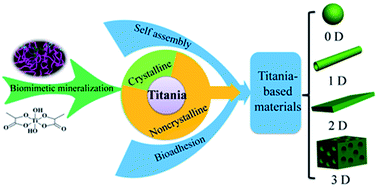Biomimetic and bioinspired synthesis of titania and titania-based materials
Abstract
Titania, one of the most important metal oxides, is extremely useful in a broad range of applications due to its unique physical/chemical properties as well as good biocompatibility. Inspired by the exquisite biomineralization process in nature, biomimetic and bioinspired methods which utilize biomolecules and their mimics as the inducers have been evolved as a novel protocol for facile, efficient synthesis of titania and titania-based materials. Compared to the most commonly employed sol–gel, hydrothermal methods, the biomimetic and bioinspired methods are often conducted under much milder conditions (aqueous solution, neutral or near neutral pH, ambient temperature and pressure). In this review, the representative advances have been highlighted for the biomimetic mineralization of titania and titania-based materials over the past decades. According to the types of inducers, the biomimetic and bioinspired synthesis of titania with noncrystalline and crystalline phase via proteins, designed peptides and their mimics have been reviewed. Moreover, the synthesis of titania-based materials through this biomimetic and bioinspired strategy coupled with self-assembly or bioadhesion has also been presented. This review may shed light on the exploration of a green, controllable platform for synthesis of diverse kinds of inorganic materials.


 Please wait while we load your content...
Please wait while we load your content...